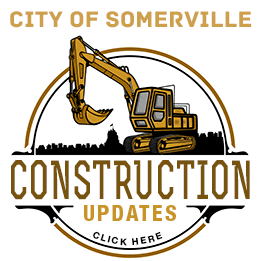
By William C. Shelton
(The opinions and views expressed in the commentaries and letters to the Editor of The Somerville Times belong solely to the authors and do not reflect the views or opinions of The Somerville Times, its staff or publishers)
For eighteen years, Somerville citizens and their elected officials have advocated extensive commercial development as a means of curing the city’s fiscal ills. Now City planning staff have found another way to rebuff them. Planning Director George Proakis and Senior Planner Dan Bartman rolled it out at a February 4 public forum on Union Square/Boynton Yards redevelopment.
Somerville citizens, the mayoral-appointed Civic Advisory Committee, and the Board of Aldermen had all stated that committing only 60% of new development in the district to commercial uses would be insufficient to meet the city’s considerable fiscal needs. Mr. Proakis and Mr. Bartman now say that we should build substantially less than 60%.
A tiny commercial tax base is why our city must rely on state welfare to meet a quarter of its budget. It is why we can do so little for our middle- and lower-income residents.
Conversely, a thriving commercial tax base is why Cambridge homeowners pay taxes at only 55% the rate that Somerville homeowners pay. It’s why Cambridge schools can spend 56% more per pupil than our schools spend.
And while we struggle to make fiscal ends meet, we anticipate major new financial obligations. We need a new high school. We need new police and fire stations. We need a new library. And we’re getting by on luck and prayer with a half-century-out-of-date sewer system whose nine-figure replacement costs go up every year.
We need to increase city revenues without further burdening homeowners. Many long-time ‘Villens who by now have low or no mortgage payments are still being forced from their homes by tax increases.
Mr. Proakis acknowledges that commercial property generates three times the net tax revenue that residential property of the same value does. But he and Mr. Bartman say that we need even less of it than the already inadequate amounts specified by the Draft Neighborhood Plan that their consultants released in November.
Their rationale begins with SomerVision, the 2012 comprehensive plan that was intended to guide development policy across the city. It set goals of creating 6,000 new housing units and 30,000 new jobs by 2030. For the Union Square/Boynton Yards neighborhood it set goals of 900,000 square feet of new residential space that would house 850 new units, and 1.5 million square feet of commercial space that would host 4,300 new jobs.
But at the February 8 meeting, we were told that SomerVision’s steering committee members and planners got it wrong. First, they did not use the correct sizes of developable parcels, roads and public ways. So instead of the redevelopment area having 48 developable acres, it has 38.5.
Then, Inner Belt and Brickbottom—two of the “transform districts” where SomerVision allocated new jobs and housing units—will take longer to develop than the time remaining in the SomerVision plan. So we need to cram more jobs and housing units into Union Square/Boynton Yards if we are going to meet SomerVision’s goals on time.
But, they say, offices require a lot less space per worker now than they once did. And we can reduce the average amount of built space per housing unit from 1,100 square feet to 900, which translates into about 720 square feet of living space. Then, we can build a lot less commercial space and a lot more residential space.
So we can lower the commercial space goal from 60%, which those who are paying attention have long said is too little, down to 44%, while the residential space goal would increase from 40% to 56%. The housing-units goal would go from 850 to 3,350, and jobs, from 4,300 to 8,200.
This rationale begs some compelling questions:
- While we need to correct Somerville’s extreme jobs-to-workers imbalance, we have a more constraining need to pay our bills and to enable people already living here to remain. So if we have less acreage to work with than we thought, and commercial space generates three times as much tax revenue as residential space, why wouldn’t we want more space committed to office and R&D uses, not less?
- A brief visit to the Inner Belt district makes clear that its limitations won’t just prevent it from meeting SomerVision’s timetable. They will prevent it from ever having the employer-attractive infrastructure and amenities that Union Square/Boynton Yards will enjoy. So wouldn’t we want to ensure that an even larger proportion of Union Square/Boynton Yards is preserved for commercial development, while increasing Inner Belt’s proportion of residential development?
- The scenario in which Union Square/Boynton Yards could achieve its highest value development, contributing the most tax revenue to benefit us all, is as a “safety valve” for Kendall Square. But biotech companies’ space allocations are not less than SomerVision’s 350-square-feet-per-worker assumption. They are more. So why should we assume that we’ll be recruiting companies that deliver us less value?
Throughout the planning process, ‘Villens have advocated for more commercial development than the amounts specified in SomerVision. The Board of Aldermen weighed in on their side in March. And residents made their preferences clear in Somerville-by-Design forums conducted by consultants hired to draft a neighborhood plan.
In response, the consultants issued a city-staff-approved draft plan that rejected these expressed preferences, while increasing the housing unit target by 365%. Planning staff solicited comments on the draft. Those comments that spoke to the commercial/residential mix mostly advocated for more commercial development. But on February 4th, the city administration doubled down by drastically tilting the mix further in the wrong direction.
Despite his repeatedly rejecting residents’ and aldermen’s expressed preferences, Mr. Proakis told outraged attendees that he had “put up numbers…based on what people are telling us to do.” He went on to say, “I cannot afford right now to spend another six months debating assumptions.”
Yes, administration officials are now suggesting that if those advocating wise development policy don’t shut up and accept a self-defeating neighborhood plan, Commonwealth and MBTA officials may kill the Green Line. I would appreciate seeing any solid evidence that might support such a claim.
GLX Interim Manager Jack Wright stated at a February 5 meeting here that the extension could not be built without the Union Square spur. Congressman Capuano, who facilitated the $1 billion federal commitment to the project, expects it to be built. Indeed, violation of the court order that mandated the GLX could threaten all of Massachusetts’ federal transportation funding.
Somerville citizens have invested many thousands of hours in learning the issues, considering the alternatives, participating in committees, giving testimony, and submitting comments. If they are to be ignored, city officials can save us a lot of time and effort by acknowledging that these activities are just window dressing, mobilized to project an illusion of public participation in policy making.
















well said. It is shameful to sell the cities future over things not happening fast enough. We have a fixed amount of land and as much time as we need to build what we want to accomplish those goals. Lets to it right and bring jobs rather than rushing to build housing.
So if offices require a lot less space per worker now than they once did. And we can reduce the average amount of built space per housing unit from 1,100 square feet to 900…wouldn’t there be a lot less “cramming” of jobs and housing units into Union Square/Boynton Yards because Inner Belt will never develop? …as compared to using the original numbers in SV? Wouldn’t using those original assumptions have resulted in more development?
Bill, aren’t you highlighting a reduction in floor space but an increase in jobs/housing…meaning smaller buildings but achieving more goal? Sounds more efficient.
The development at Innerbelt and Brickbottom is coming, it just won’t come on line fast enough to meet the benchmarks set by SomerVision, so we have to adjust our expectations from other parcels accordingly. But this is where we caught a break. Office spaces do indeed require a lot less space per worker now – down to 125 to 225 square feet per person from 350 square feet per person. Even the biotech offices that seem to be presented as the holy grail here only have higher space requirements (up to about 500 square feet per person for lab space) for a small percentage of their staff.
Yes, we need commercial space, but the fact is we can plan to get more workers in less space due to the market reality that companies are buying less space per worker now than before 2008. That frees up more of the square footage in this particular area (because that’s what the change applies to – staff are not proposing to change the balance of commercial and residential for the entire city) for more housing WHICH WE ALSO NEED to help address the skyrocketing demand (and correspondingly stratospheric costs) for residential space.
The 60/40 split was never meant to apply to each location individually, but as an over all total for new development. So we would need to see a balance being made elsewhere.
The fact of the matter is, there is a massive demand for housing in Somerville and not a huge demand for commercial space. If you build it, they won’t necessarily come…we’ll just end up giving companies tax breaks to locate here. Better to build the housing which we know is in demand.
I am a homeowner Somerville, and I have lived in many states and cities in the US. In my opinion, the residential tax reduction to Somerville homeowners after one year if VERY VERY generous. In my opinion, there is absolutely no reason why I should get a large reduction after one year. I live in Somerville I expect to pay my fair share like everyone else who lives here. I have also lived abroad and I have never heard of a massive real estate reduction for residents. The city cannot afford it obviously.
Very true. We are getting a massive break that is maybe a bit too generous, to the city’s detriment. I won’t complain, but I wonder if the city as a whole wouldn’t be better off without it.
UnionSq resident, i disagree, we need to look at the bigger picture. We don’t want to be relegated to just be a bedroom community because it is not sustainable (economically or socially). We need to have balance.
The shills seem to be ignoring the main point of this article, which “those who are paying attention” know is also what will decide Somerville’s future.
Will we build a lot more office and lab space, or a lot more housing for highly paid people? Will we pay for the things that a healthy city needs by increasing commercial tax revenue or by driving working class homeowners and renters out of town? Will we be a community, or a giant collection of bedrooms for people who live here for awhile, spend money at night in local bars, and then move on?
“Union Square Resident” is mistaken. A real estate consultant that works for US2 told a big meeting at the Post Office a year ago that her company hears a lot of interest in the neighborhood from commercial tenants. But there is no place for them to move to.
JM, look at the number of residential units in the city, then look at the number that get the residential tax discount. The huge majority of residences are not owner occupied and do not get that rate.
There is a lot of demand for both commercial and residential units. The problem is that for commercial, people don’t find what they need. And for residential, you can just build cheap modern crap, call it “luxury” and then expect the same demand for those units. One of the things that attracts people to Somerville is the character of the old architecture. Builders of residential community need to do a better job with design. The large apartment/condo buildings I see in Assembly and other places around town are just ugly. Sure, it’s my opinion but I’m sure that others share the opinion.
Trust me, more and more families like mine are starting to stick around. We have had one of the largest Kindergarten enrollment increases in the state over the last 4 years.
Last night the Board of Aldermen stepped up and made themselves unequivocally heard on this matter. I am so proud of them.
They unanimously voted to send a zoning amendment drafted by Bill White to the Land Use Committee and Planning Board for a public hearing and, ultimately, a vote.
The amendment designates large areas of Union Square, Boynton Yards, Assembly Square, Brickbottom and Inner Belt as “Critical Economic Development Districts” Within those districts, 68% of any new development on parcels of 10,000 square feet or more and three or more housing units must be office, R&D, and biotech uses.
All the aldermen present spoke to the amendment. Their comments are informative and uplifting. They begin at 54:30, here: http://somervillecityma.iqm2.com/Citizens/SplitView.aspx?Mode=Video&MeetingID=2186&Format=Agenda
Bill-
Thanks for including this information!